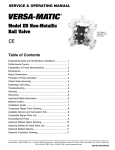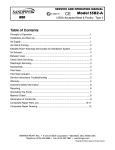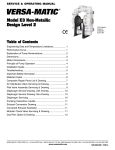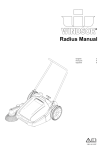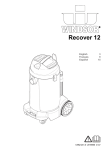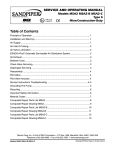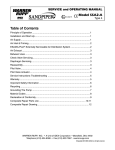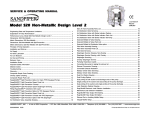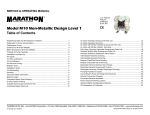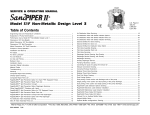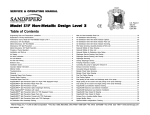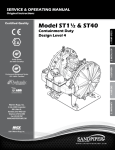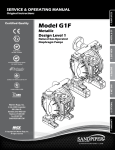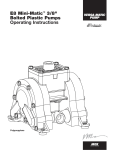Download E6 Non-Metallic
Transcript
SERVICE & OPERATING MANUAL ® Model E6 Non-Metallic Ball Valve U.S. Patent # 5,996,627 and 6,241,487 CE Table of Contents Engineering Data and Temperature Limitations.................... 1 Performance Curves ............................................................. 1 Explanation of Pump Nomenclature ..................................... 2 Dimensions .......................................................................... 3 Metric Dimensions ................................................................ 4 Principle of Pump Operation ................................................ 5 Check Valve Servicing ......................................................... 5 Diaphragm Servicing ............................................................ 5 Troubleshooting .................................................................... 6 Warranty ............................................................................... 6 Recycling ............................................................................. 6 Important Safety Information ................................................. 6 Material Codes ..................................................................... 7 Installation Guide ................................................................. 7 Composite Repair Parts Drawing ......................................... 8 Available Service and Conversion Kits ................................ 8 Composite Repair Parts List ................................................. 9 Grounding the Pump ............................................................ 9 Solenoid Shifted Option Drawing ....................................... 10 Solenoid Shifted Air Valve Parts List .................................. 10 Solenoid Shifted Options .................................................... 11 Solenoid Connector Drawing ............................................. 11 VERSA-MATIC PUMP • A Unit of IDEX Corporation • 6017 Enterprise Drive, Export, PA 15632-8969 USA • Phone (724) 327-4867 524-8388 • Fax (724) 327-4300 www.versamatic.com 520-361-000 04/04 ® ® Model E6 Non-Metallic Ball Valve Quality System ISO9001 Certified Air-Powered Double-Diaphragm Pump U.S. Patent # 5,996,627 and 6,241,487 INTAKE/DISCHARGE PIPE SIZE ¼" (6mm) NPT(internal) ½" (13mm) NPT (external) CAPACITY 0 to 4 gallons per minute (0 to 15 liters per minute) Engineering, Performance & Construction Data CE AIR VALVE No-lube, no-stall design SOLIDS-HANDLING Up to 1/32" (1mm) HEADS UP TO DISPLACEMENT/STROKE 125 psi or 289 ft. of water (8.6 Kg/cm2 or 86 meters) .01 US Gallons / .04 liters CAUTION! Operating temperature limitations are as follows: Materials Maximum* Santoprene® Injection molded thermoplastic elastomer with no fabric layer. Long mechanical flex life. Excellent abrasion resistance. Virgin PTFE Chemically inert, virtually impervious. Very few chemicals are known to react chemically with PTFE: molten alkali metals, turbulent liquid or gaseous fluorine and a few fluoro-chemicals such as chlorine trifluoride or oxygen difluoride which readily liberate free fluorine at elevated temperatures. PVDF 212°F Operating Temperatures Minimum* Optimum** -10°F -23°C 50° to 212°F 10° to 100°C 212°F -35°F -37°C 50° to 212°F 10° to 100°C 200°F 10°F -23°C 40°F 5°C -20°F -28°C 100°C 100°C Polypropylene 93°C 150°F 65°C Conductive Acetal 180°F 82°C PERFORMANCE CURVES (Versa-Matic® pumps are designed to be powered only by compressed air) Maximum air consumption for any point on the performance curve is 3 LPS. Contact the factory for exact air consumption. TOTAL HEAD IN PSI TOTAL HEAD IN Kg/cm2 Maximum air consumption for any point on the performance curve is 6 SCFM. Contact the factory for exact air consumption. CAPACITY IN US GALLONS PER MINUTE CAPACITY IN LITERS PER MINUTE Santoprene® is a registered tradename of Monsanto Corp. Versa-Matic® is a registered tradenames of Versa-Matic, Inc. Model E6 Non-Metallic 1 520-361-000 Page 12 1 Available Pump Models E6 Non-Metallic MODEL TYPE Pump Size Wetted Material Non-Wetted Material Diaphragm Material Diaphragm Series Valve Ball Material Wetted Seals Type of Construction Options E6PP6X650 6 P P 6 X 6 5 0 – E6PP6X550 E6PP5B550 E6KP6X650 E6KP6X550 E6KP5B550 E6GG6X650 E6GG6X550 E6GG5B550 E6PP6X650-E0 E6PP6X650-E1 E6PP6X650-E2 E6PP6X650-E3 E6PP6X650-E4 E6PP6X650-E5 E6PP6X650-E6 E6PP6X650-E7 6 6 6 6 6 6 6 6 6 6 6 6 6 6 6 6 P P K K K G G G P P P P P P P P P P P P P G G G P P P P P P P P 6 5 6 6 5 6 6 5 6 6 6 6 6 6 6 6 X B X X B X X B X X X X X X X X 5 5 6 5 5 6 5 5 6 6 6 6 6 6 6 6 5 5 5 5 5 5 5 5 5 5 5 5 5 5 5 5 0 0 0 0 0 0 0 0 0 0 0 0 0 0 0 0 – – – – – – – – E0 E1 E2 E3 E4 E5 E6 E7 Explanation of Pump Nomenclature: E 6 P P 6 X 6 5 0 – XXX PUMP MODEL E = Elima-Matic® TYPE OF CONSTRUCTION 0 = Clamped Style PUMP SIZE 6 = ¼" Pipe Size WETTED SEALS 5 = PTFE WETTED MATERIAL G = Groundable Acetal P = Polypropylene K = PVDF VALVE BALL MATERIAL 5 = PTFE 6 = XL NON-WETTED MATERIAL P = Polypropylene/Delrin/SS G = Conductive Acetal DIAPHRAGM MATERIAL 5 = PTFE 6 = XL (Santoprene) 520-361-000 Page 2 DIAPHRAGM SERIES X = Thermo-Matic™. bead style B = Versa-Tuff, 1 piece PTFE OPTIONS E0 = Solenoid Kit w/24 VDC Coil E1 = Solenoid Kit w/24 VDC Explosion Proof Coil E2 = Solenoid Kit w/24 VAC/12VDC Coil E3 = Solenoid Kit w/24 VAC/12VDC Explosion Proof Coil E4 = Solenoid Kit w/110VAC Coil E5 = Solenoid Kit w/110VAC Explosion Proof Coil E6 = Solenoid Kit w/220VAC Coil E7 = Solenoid Kit w/220VAC Explosion Proof Coil Model E6 Non-Metallic Dimensions: E6 Non-Metallic Model E6 Non-Metallic 1 Dimension A B C Standard 7" 3.1/8" 5.1/2" Pulse Output Kit 9" 3.9/16" 5.15/16" 520-361-000 Page 12 3 Metric Dimensions: E6 Non-Metallic Dimension 520-361-000 Page 4 A B C Standard 178 79 140 Pulse Output Kit 229 90 151 Model E6 Non-Metallic PRINCIPLE OF PUMP OPERATION This ball type check valve pump is powered by compressed air and is a 1:1 ratio design. The inner side of one diaphragm chamber is alternately pressurized while simultaneously exhausting the other inner chamber. This causes the diaphragms, which are connected by a common rod secured by plates to the centres of the diaphragms, to move in a reciprocating action. (As one diaphragm performs the discharge stroke the other diaphragm is pulled to perform the suction stroke in the opposite chamber.) Air pressure is applied over the entire inner surface of the diaphragm while liquid is discharged from the opposite side of the diaphragm. The diaphragm operates in a balanced condition during the discharge stroke which allows the pump to be operated at discharge heads over 200 feet (61 meters) of water. For maximum diaphragm life, keep the pump as close to the liquid being pumped as possible. Positive suction head in excess of 10 feet of liquid (3.048 meters) may require a back pressure regulating device to maximize diaphragm life. Alternate pressurizing and exhausting of the diaphragm chamber is performed by an externally mounted, pilot operated, four way spool type air distribution valve. When the spool shifts to one end of the valve body, inlet pressure is applied to one diaphragm chamber and the other diaphragm chamber exhausts. When the spool shifts to the opposite end of the valve body, the pressure to the chambers is reversed. The air distribution valve spool is moved by a internal pilot valve which alternately pressurizes one end of the air distribution valve spool while exhausting the other end. The pilot valve CHECK VALVE SERVICING Need for inspection or service is usually indicated by poor priming, unstable cycling, reduced performance or the pump's cycling but not pumping. Remove the sixteen machine screws securing the manifold assemblies to the outer chambers. Inspect the surfaces of both check valve and seat for wear or damage that could prevent proper sealing. If pump is to prime properly, valves must seat air tight. DIAPHRAGM SERVICING Remove the two V-Band clamps securing the outer chambers to the intermediate housing. Remove the diaphragm assembly (outer plate, diaphragm, inner plate) by turning the assembly counterclockwise using a ½" (1.27 cm) wrench on the outer plate lugs. (If a socket is used, it must be a six point socket.) The interior components consisting of the shaft seal and pilot valve assembly are now accessible for service. Procedures for reassembling the diaphragms are the reverse of the above. Install the diaphragm with the natural bulge outward. Install the outer diaphragm plate on the outside of the diaphragm and make certain that the large radius side of the inner plate is toward the diaphragm. Tighten the outer diaphragm plate to approximately 30 in./lbs. (3.39 Newton meters). Torque while allowing the diaphragm to turn freely with plates. Use a wrench on the outer diaphragm plate of the opposite side to keep rod from rotating. If the opposite chamber is assembled, the rad need not be held. Model E6 Non-Metallic 1 is shifted at each end of the diaphragm stroke when a actuator plunger is contacted by the diaphragm plate. This actuator plunger then pushes the end of the pilot valve spool into position to activate the air distribution valve. The chambers are connected with manifolds with a suction and discharge check valve for each chamber, maintaining flow in one direction through the pump. INSTALLATION AND START-UP Locate the pump as close to the product being pumped as possible. Keep the suction line length and number of fittings to a minimum. Do not reduce the suction line diameter. For installations of rigid piping, short sections of flexible hose should be installed between the pump and the piping. The flexible hose reduces vibration and strain to the pumping system. A surge suppressor is recommended to further reduce pulsation in flow. AIR SUPPLY Air supply pressure cannot exceed 100 psi (8.6 bar). Connect the pump air inlet to an air supply of sufficient capacity and pressure required for desired performance. When the air supply line is solid piping, use a short length of flexible hose not less than ½" (13mm) in diameter between the pump and the piping to reduce strain to the piping. The weight of the air supply line, regulators and filters must be supported by some means other than the air inlet cap. Failure to provide support for the piping may result in damage to the pump. A pressure regulating valve should be installed to insure air supply pressure does not exceed recommended limits. EXTERNALLY SERVICEABLE MAIN AIR DISTRIBUTION VALVE To service the main air distribution, first shut-off and disconnect the air supply to the pump. Remove the four long hex cap screws and hex nuts (on opposite side of pump) which fasten the main air valve body (item 1), gaskets (item 8 and 11), muffler (item 14), and caps (item 6 and 15) to the pump. Once the main air valve body is off the pump remove the retaining rings (items 7) that hold the end caps in place. Remove the end caps (items 6) to inspect the spool and sleeve. Remove the main air spool (part of item 2) and inspect for damage or wear. Inspect the inside diameter of the main air valve (item 2) for dirt, scratches, or other contaminants. Remove and replace the sleeve if needed. When reinstalling the sleeve, apply a light coating of grease to the six o-rings (item 3) before inserting the sleeve into the main air valve body. Align the holes in the sleeve with the slots in main valve body, making sure the sleeve is centered in the bore. Clean the main air valve spool, lightly grease the o-rings, and insert into the sleeve flush to one end. Reinstall the end caps and retaining rings. The main air valve body is now ready to put back on the pump. Assemble the air inlet cap (item 9), valve body gasket (item 8), to the main air valve body (making sure the five rectangular slots face the air inlet cap), and the intermediate gasket onto the four hex capscrews and install onto the pump. Slide the muffler (item 14) and the exhaust cap (item 15) over the capscrews. Re-install the washers (item 10) and hex nuts (items 16) onto the four hex capscrews and torque to 30 in/lbs. (3.39 Newton meters). AIR VALVE LUBRICATION BETWEEN USES The air distribution valve and the pilot valve are designed to operate WITHOUT lubrication. This is the preferred mode of operation. There may be instances of personal preference or poor quality air supplies when lubrication of the compressed air supply is required. The pump air system will operate with properly lubricated compressed air supply. Proper lubrication requires the use of an air line lubricator (available from VersaMatic) set to deliver one drop of SAE 10 non-detergent oil for every 20 SCFM (9.4 liters/sec.) of air the pump consumes at the point of operation. Consult the pump’s published Performance Curve to determine this. AIR LINE MOISTURE When the pump is used for materials that tend to settle out or solidify when not in motion, the pump should be flushed after each use to prevent damage. (Product remaining in the pump between uses could dry out or settle out. This could cause problems with the diaphragms and check valves at restart.) In freezing temperatures the pump must be completely drained between uses in all cases. Water in the compressed air supply can create problems such as icing or freezing of the exhaust air, causing the pump to cycle erratically or stop operating. Water in the air supply can be reduced by using a point-of-use air dryer to supplement the user’s air drying equipment. This device removes water from the compressed air supply and alleviates the icing or freezing problems. Figure 1 AIR INLET AND PRIMING To start the pump, open the air valve approximately ½ to ¾ turn. After the pump primes, the air valve can be opened to increase air flow as desired. If opening the valve increases cycling rate, but does not increase the rate of flow, cavitation has occurred. The valve should be closed slightly to obtain the most efficient air flow to pump flow ratio. SERVICING THE PILOT VALVE To remove the pilot valve spool (item 23) first remove the end o-ring (item 24) from one end of spool. Slide the spool out of the sleeve and inspect the five remaining o-rings (items 24) for damage or wear. If necessary, replace damaged o-rings. Inspect the inner diameter of pilot valve sleeve (item 20) for scratches, dirt, or other contaminants. Replace the sleeve if necessary. To remove the sleeve first remove the retaining ring from one end. When installing a pilot valve sleeve first lightly grease the six o-rings (items 21). Insert the sleeve into the chamfered end of bore on the intermediate bracket (item 13). Push the sleeve in until the shoulder is flush to intermediate bracket surface and install the retaining ring (item 22). To install the pilot valve spool first lightly grease the four interior o-rings and insert into the pilot valve sleeve. After inserting the spool into the sleeve install the remaining loose o-rings onto spool. SERVICING DIAPHRAGM ROD SEALS To service the rod seals (item 18) first remove pilot valve, then remove the inserts on each of the intermediate brackets (item 17) by prying them out with a small flat screwdriver. After removing the inserts take the K-R rod seals out of the inserts and replace. When reinstalling the seals, make sure the open side of the seals face into the counterbore in the inserts. To install the inserts into intermediate bracket, simply press the insert into the counterbore in each of the intermediate bracket, making sure that the closed side of insert faces out. The inserts should be flush to the surface of the intermediate bracket or slightly below the surface when fully installed. Figure 2 Figure 3 Figure 4 520-361-000 Page 12 5 TROUBLESHOOTING Possible Symptoms: • Pump will not cycle. • Pump cycles, but produces no flow. • Pump cycles, but flow rate is unsatisfactory. • Pump cycle seems unbalanced. • Pump cycle seems to produce excessive vibration. What to Check: Excessive suction lift in system. Corrective Action: For lifts exceeding 20 feet (6 meters), filling the pumping chambers with liquid will prime the pump in most cases. What to Check: Excessive flooded suction in system. Corrective Action: For flooded conditions exceeding 10 feet (3 meters) of liquid, install a back pressure device. What to Check: System head exceeds air supply pressure. Corrective Action: Increase the inlet air pressure to the pump. Most diaphragm pumps are designed for 1:1 pressure ratio at zero flow. What to Check: Air supply pressure or volume exceeds system head. Corrective Action: Decrease inlet air pressure and volume to the pump as calculated on the published PERFORMANCE CURVE. Pump is cavitating the fluid by fast cycling. What to Check: Undersized suction line. Corrective Action: Meet or exceed pump connection recommendations shown on the DIMENSIONAL DRAWING. What to Check: Restricted or undersized air line. Corrective Action: Install a larger air line and connection. Refer to air inlet recommendations shown in your pump’s SERVICE MANUAL. What to Check: Check ESADS, the Externally Serviceable Air Distribution System of the pump. Corrective Action: Disassemble and inspect the main air distribution valve, pilot valve and pilot valve actuators. Refer to the parts drawing and air valve section of the SERVICE MANUAL. Check for clogged discharge or closed valve before reassembly. What to Check: Rigid pipe connections to pump. Corrective Action: Install flexible connectors and a Versa-Matic® surge suppressor. What to Check: Blocked air exhaust muffler. Corrective Action: Remove muffler screen, clean or de-ice and reinstall. Refer to the Air Exhaust section of your pump SERVICE MANUAL. WARNING! Read these safety warnings and instructions in this manual COMPLETELY, before installation and start-up of the pump. It is the responsibility of the purchaser to retain this manual for reference. Failure to comply with the recommendations stated in this manual will damage the pump, and void factory warranty. What to Check: Pumped fluid in air exhaust muffler. Corrective Action: Disassemble pump chambers. Inspect for diaphragm rupture or loose diaphragm plate assembly. Refer to the Diaphragm Replacement section of your pump SERVICE MANUAL. What to Check: Suction side air leakage or air in product. Corrective Action: Visually inspect all suction side gaskets and pipe connections. What to Check: Obstructed check valve. Corrective Action: Disassemble the wet end of the pump and manually dislodge obstruction in the check valve pocket. Refer to the Check Valve section of the pump SERVICE MANUAL for disassembly instructions. What to Check: Worn or misaligned check valve or check valve seat. Corrective Action: Inspect check valves and seats for wear and proper seating. Replace if necessary. Refer to Check Valve section of the pump SERVICE MANUAL for disassembly instructions. What to Check: Blocked suction line. Corrective Action: Remove or flush obstruction. Check and clear all suction screens and strainers. WARNING! Before maintenance or repair, shut off the compressed air line, bleed the pressure, and disconnect the air line from the pump. The discharge line may be pressurized and must be bled of its pressure. WARNING! Take action to prevent static sparking. Fire or explosion can result, especially when handling flammable liquids. The pump, piping, valves, containers or other miscellaneous equipment must be grounded. 520-361-000 Page 6 What to Check: Entrained air or vapor lock in one or both pumping chambers. Corrective Action: Purge chambers through tapped chamber vent plugs. PURGING THE CHAMBERS OF AIR CAN BE DANGEROUS! Contact the Versa-Matic Technical Services Department before performing this procedure. Any model with top-ported discharge will reduce or eliminate problems with entrained air. If your pump continues to perform below your expectations, contact your local Versa-Matic Distributor or factory Technical Services Group for a service evaluation. Warranty: This pump is warranted for a period of five years against defective material and workmanship. Failure to comply with the recommendations stated in this manual voids all factory warranty. WARNING! Airborne particles and loud noise hazards. Wear ear and eye protection. In the event of diaphragm rupture, pumped material may enter the air end of the pump, and be discharged into the atmosphere. If pumping a product which is hazardous or toxic, the air exhaust must be piped to an appropriate area for safe disposition. IMPORTANT! This pump is pressurized internally with air pressure during operation. Always make certain that all bolting is in good condition and that all of the correct bolting is reinstalled during assembly. CAUTION! Before pump operation, inspect all gasketed fasteners for looseness caused by gasket creep. Re-torque loose fasteners to prevent leakage. Follow recommended torques stated in this manual. What to Check: Blocked pumping chamber. Corrective Action: Disassemble and inspect the wetted chambers of the pump. Remove or flush any obstructions. WARNING! WARNING! Before doing any maintenance on the pump, be certain all pressure is completely vented from the pump, suction, discharge, piping, and all other openings and connections. Be certain the air supply is locked out or made non-operational, so that it cannot be started while work is being done on the pump. Be certain that approved eye protection and protective clothing are worn all times in the vicinity of the pump. Failure to follow these recommendations may result in serious injury or death. What to Check: Blocked discharge line. Corrective Action: Check for obstruction or closed discharge line valves. WARNING! When used for toxic or aggressive fluids, the pump should always be flushed clean prior to disassembly. RECYCLING Many components of Versa-Matic Metallic AODD pumps are made of recyclable materials (see chart on page 9 for material specifications). We encourage pump user to recycle worn out parts and pumps whenever possible, after any hazardous pumped fluids are thoroughly flushed. Model E6 Non-Metallic MATERIAL CODES The Last 3 Digits of Part Number 000 ......... Assembly, sub-assembly; and some purchased items 010 ......... Cast Iron 012 ......... Powered Metal 015 ......... Ductile Iron 020 ......... Ferritic Malleable Iron 025 ......... Music Wire 080 ......... Carbon Steel, AISI B-1112 100 ......... Alloy 20 110 ......... Alloy Type 316 Stainless Steel 111 ......... Alloy Type 316 Stainless Steel (Electro Polished) 112 ......... Alloy “C” (Hastelloy equivalent) 113 ......... Alloy Type 316 Stainless Steel (Hand Polished) 114 ......... 303 Stainless Steel 115 ......... 302/304 Stainless Steel 117 ......... 440-C Stainless Steel (Martensitic) 120 ......... 416 Stainless Steel (Wrought Martensitic) 123 ......... 410 Stainless Steel (Wrought Martensitic) 148 ......... Hardcoat Anodized Aluminium 149 ......... 2024-T4 Aluminium 150 ......... 6061-T6 Aluminium 151 ......... 6063-T6 Aluminium 152 ......... 2024-T4 Aluminium (2023-T351) 154 ......... Almag 35 Aluminium 155 ......... 356-T6 Aluminium 156 ......... 356-T6 Aluminium 157 ......... Die Cast Aluminium Alloy #380 158 ......... Aluminium Alloy SR-319 159 ......... Anodized Aluminium 162 ......... Brass, Yellow, Screw Machine Stock 165 ......... Cast Bronze, 85-5-5-5 166 ......... Bronze, SAE 660 170 ......... Bronze, Bearing Type, Oil Impregnated 175 ......... Die Cast Zinc 180 ......... Copper Alloy 305 ........ Carbon Steel, Gray Epoxy Coated 306 ........ Carbon Steel, Black PTFE Coated 307 ........ Aluminium, Gray Epoxy Coated 308 ........ Stainless Steel, Black PTFE Coated 309 ........ Aluminium, Black PTFE Coated 310 ......... Kynar Coated 330 ......... Zinc Plated Steel 331 ......... Chrome Plated Steel 332 ......... Aluminium, Electroless Nickel Plated 333 ......... Carbon Steel, Electroless Nickel Plated 335 ......... Galvanized Steel 336 ......... Zinc Plated Yellow Brass 337 ......... Silver Plated Steel 340 ......... Nickel Plated 342 ......... Filled Nylon 353 ......... Geolast; Color: Black 354 ......... Injection Molded #203-40 Santoprene- Duro 40D +/-5; Color: RED 355 ......... Thermal Plastic 356 ......... Hytrel 357 ......... Injection Molded Polyurethane 358 ......... (Urethane Rubber) (Compression Mold) 359 ......... Urethane Rubber 360 ......... Buna-N Rubber. Color coded: RED 361 ......... Buna-N 363 ......... Viton (Flurorel). Color coded: YELLOW 364 ......... EPDM Rubber. Color coded: BLUE 365 ......... Neoprene Rubber. Color coded: GREEN 366 ......... Food Grade Nitrile 368 ......... Food Grade EPDM 370 ......... Butyl Rubber. Color coded: BROWN 371 ......... Philthane (Tuftane) 374 ......... Carboxylated Nitrile 375 ......... Fluorinated Nitrile 378 ......... High Density Polypropylene 405 ......... Cellulose Fibre 408 ......... Cork and Neoprene 425 ......... Compressed Fibre 426 ......... Blue Gard 440 ......... Vegetable Fibre 465 ......... Fibre 500 ......... Delrin 500 501 ......... Delrin 570 502 ......... Conductive Acetal, ESD-800 503 ......... Conductive Acetal, Glass-Filled 505 ......... Acrylic Resin Plastic 506 ......... Delrin 150 520 ......... Injection Molded PVDF Natural color 540 ......... Nylon 541 ......... Nylon 542 ......... Nylon 544 ......... Nylon Injection Molded 550 ......... Polyethylene 551 ......... Glass Filled Polypropylene 552 553 555 556 570 580 590 591 592 600 601 602 603 604 607 606 610 611 632 633 634 635 637 638 639 643 644 656 ......... Unfilled Polypropylene ......... Unfilled Polypropylene ......... Polyvinyl Chloride ......... Black Vinyl ......... Rulon II ......... Ryton ......... Valox ......... Nylatron G-S ......... Nylatron NSB ......... PTFE (virgin material) Tetrafluorocarbon (TFE) ......... PTFE (Bronze and moly filled) ......... Filled PTFE ......... Blue Gylon ......... PTFE ......... Envelon ......... PTFE ......... PTFE Encapsulated Silicon ......... PTFE Encapsulated Viton ......... Neoprene/Hytrel ......... Viton/PTFE ......... EPDM/PTFE ......... Neoprene/PTFE ......... PTFE, Viton/PTFE ......... PTFE, Hytrel/PTFE ......... Buna-N/TFE ......... Santoprene®/EPDM ......... Santoprene®/PTFE ......... Santoprene Diaphragm and Check Balls/EPDM Seats Delrin, Viton and Hytrel are registered tradenames of E.I. DuPont. Gylon is a registered tradename of Garlock, Inc. Nylatron is a registered tradename of Polymer Corp. Santoprene is a registered tradename of Monsanto Corp. Rulon II is a registered tradename of Dixion Industries Corp. Hastelloy-C is a registered tradename of Cabot Corp. Ryton is a registered tradename of Phillips Chemical Co. Valox is a registered tradename of General Electric Co. INSTALLATION GUIDE Top Discharge Ball Valve Unit 1 Available from Versa-Matic Pump 1 VDA05 Versa-Surge Suppressor 2 020-049-000 Filter/Regulator 3 020-049-001 Lubricator 4 Air Dryer CAUTION The air exhaust should be piped to an area for safe disposition of the product being pumped, in the event of a diaphragm failure. 4 2 Model E6 Non-Metallic 1 3 520-361-000 Page 12 7 520-361-000 Page 8 Model E6 Non-Metallic 33 33 37 32 34 32 34 39 476-129-000 476-117-644 476-117-600 476-117-354 475-149-520 475-149-552 031-101-000 475-145-000 475-154-000 031-107-551 031-107-503 35 27 31 26 16 28 43 10 30 15 Main Air Valve Body Assembly (Items 1-3, 6-7) Main Air Valve Body Assembly (Conductive Acetal only) Pilot Valve Assembly (Items 20, 22-23) Air Exhaust Conversion Kit Air Exhaust Conversion Kit (Conductive Acetal only) Pail Transfer Kit in PVDF Pail Transfer Kit in Polypropylene Wetted End Kit Santoprene Diaphragms & Balls Wetted End Kit PTFE Diaphragms & Balls Wetted End Kit Santoprene Diaphragms & Balls Air End Kit Service & Accessory Kits 55 55 25 29 18 14 17 13 18 22 20 21 12 3 6 19 6 18 3 7 24 1 8 10 25 17 17 7 3 2 28 9 11 38 30 40 43 29 40 26 38 41 40 41 27 42 32 31 32 55 40 39 55 33 34 37 35 38 33 34 37 Composite Repair Parts List ITEM PART NO. 1 095-077-551 095-077-503 2 031-106-000 3 560-101-360 6 165-074-551 165-074-503 7 675-051-115 8 360-085-360 9 165-072-551 165-072-503 10 901-037-115 11 170-103-115 12 360-084-360 13 114-019-551 114-019-503 14 530-022-550 15 165-073-551 165-073-503 16 545-003-115 17449-021-551 449-021-503 18 720-031-359 19 685-046-120 20 755-038-000 21 560-066-360 22 675-047-115 23 775-038-000 24 560-029-374 25 612-147-150 26 286-069-354 286-070-600 DESCRIPTION QTY Body, Main Air Valve Body, Main Air Valve Sleeve & Spool Set O-Rings Cap, End with O-Ring Cap, End with O-Ring Ring, Retaining Gasket, Valve Body Cap, Air Inlet Cap, Air Inlet Washer, Flat 1/4" Capscrew, Hex Head 1/4-20 5" Long Gasket, Intermediate Bracket Intermediate, Bracket Intermediate, Bracket Muffler Cap, Air Exhaust Cap, Air Exhaust Nut, Hex 1/4-20UNC Insert, Gland Insert, Gland Seal, K-R Rod, Diaphragm Sleeve, Pilot Valve with O-rings O-rings Ring, Retaining - Pilot Valve Sleeve Spool, Pilot Valve with O-rings O-rings Plate, Inner Diaphragm Diaphragm Diaphragm 1 1 1 8 2 2 2 1 1 1 8 4 1 1 1 1 1 1 4 2 2 2 1 1 6 1 1 6 2 2 2 ITEM PART NO. 27 28 29 30 31 32 33 34 35 37 38 39 40 41 42 43 54 55 612-146-520 612-146-502 200-057-115 100-002-115 545-027-337 196-145-520 196-145-502 196-145-552 720-032-600 722-073-520 722-073-506 722-073-552 050-033-354 050-034-600 312-095-520 312-095-502 312-095-552 706-023-115 544-004-115 312-096-520 312-096-502 312-096-552 720-033-600 518-127-520 518-127-502 518-127-552 518-128-520 518-128-502 518-128-552 360-086-360 920-024-000 706-023-115 DESCRIPTION QTY Plate, Outer Diaphragm 2 Plate, Outer Diaphragm 2 Clamp, V-Band 2 T-Bolt 2 Nut, Hex 1/4-28UNF 2 Chamber, Outer 2 Chamber, Outer 2 Chamber, Outer 2 Seal, Check Valve 8 Seat, Check Valve 4 Seat, Check Valve 4 Seat, Check Valve 4 Ball, Check 4 Ball, Check 4 Elbow, Suction 2 Elbow, Suction 2 Elbow, Suction 2 Screw, Machine 10-32UNF x 1" Long 24 Nut, Hex Flange 10-32UNF 16 Elbow, Discharge 2 Elbow, Discharge 2 Elbow, Discharge 2 Seal, Manifold 4 Manifold, Horizontal (Optional Discharge) 1/2 Manifold, Horizontal (Optional Discharge) 1/2 Manifold, Horizontal (Optional Discharge) 1/2 Manifold, Vertical 1 Manifold, Vertical 1 Manifold, Vertical 1 Gasket, Sealing 2 Ground Strap (Conductive Acetal Units Only) 1 Screw, Machine 10-32 UNF x .88 long 8 Grounding The Pump (for Conductive Acetal Pumps only) The eyelet end is fastened to the pump hardware. The clamp end is installed to a true earth ground. This 8 foot long (244 centimeters) Ground Strap (Item 54) is shipped with the eyelet end fastened to the pump hardware. To reduce the risk of static electrical sparking, this pump must be grounded. Check the local electrical code for detailed grounding instruction and the type of equipment required. Model E6 Non-Metallic 1 520-361-000 Page 12 9 SOLENOID SHIFTED OPTION DRAWING SOLENOID SHIFTED AIR VALVE PARTS LIST (Includes all items used on Composite Repair Parts List except as shown) ITEM PART NUMBER DESCRIPTION 22 44 45 46 47 48 Ring, Retaining - Pilot Plug Sleeve Pilot Plug Sleeve with O-rings Gasket, Intermediate Bracket Connector, conduit Solenoid Valve, NEMA 4 Solenoid Coil, 24 VDC Solenoid Coil, 24 VAC/12 VDC Solenoid Coil, 120 VAC Solenoid Coil, 240 VAC Tube Fitting Nipple Tee, Pipe Tubing Tube Fitting 49 50 51 52 53 675-047-115 755-037-000 360-106-360 241-001-000 893-095-000 219-001-000 219-004-000 219-002-000 219-003-000 866-068-000 538-083-555 835-009-555 860-062-540 866-069-000 QTY 2 1 1 1 1 1 1 1 1 1 1 1 1 1 ASSEMBLY INSTRUCTIONS: MUST BE PERFORMED PRIOR TO START-UP. The tee (item 51), nipple (item 50), fitting (item 53) and tubing (item 52) have been pre-assembled at the factory. Thread this assembly into the air inlet cap (item 9). Be careful not to over tighten. Push the free end of the tubing into the fitting (item 49) which is attached to the valve. For Explosion Proof Solenoid Valve (Connector not required for explosion proof coil; coil is integral with valve) 47 893-096-001 893-096-002 893-096-003 893-096-004 520-361-000 Page 10 Solenoid Valve, NEMA 7/9, 24VDC Solenoid Valve, NEMA 7/9, 24VAC/12VDC Solenoid Valve, NEMA 7/9, 120VAC Solenoid Valve, NEMA 7/9, 240VAC 1 1 1 1 Model E6 Non-Metallic SOLENOID SHIFTED AIR DISTRIBUTION VALVE OPTION Versa-Matic’s solenoid shifted, air distribution valve option utilizes electrical signals to precisely control your pump’s speed. The solenoid coil is connected to the Versa-Matic Solenoid Rate Controller/Batch Control, or a customer - supplied control. Compressed air provides the pumping power, while electrical signals control pump speed (pumping rate). OPERATION The Solenoid Shifted Versa-Matic pump has a solenoid operated, air distribution valve in place of the standard Versa-Matic’s pilot operated, air distribution valve. Where a pilot valve is normally utilized to cycle the pump’s air distribution valve, an electric solenoid is utilized. As the solenoid is powered, one of the pump’s air chambers is pressurized while the other chamber is exhausted. When electric power is turned off, the solenoid shifts and the pressurized chamber is exhausted while the other chamber is pressurized. By alternately applying and removing power to the solenoid, the pump cycles much like a standard pump, with one exception. This option provides a way to precisely control and monitor pump speed. BEFORE INSTALLATION Before wiring the solenoid, make certain it is compatible with your system voltage. Solenoid Connector Before wiring, remove terminal block from conduit connector. Model E6 Non-Metallic 1 Wiring Diagram 3rd Terminal for ground. #2 Terminal Neutral (Negative) #1 Terminal Power (Positive) 520-361-000 Page 12 11












